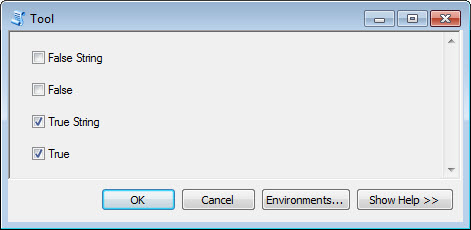- Home
- :
- All Communities
- :
- Developers
- :
- Python
- :
- Python Questions
- :
- Re: in a pyt (python toolbox): How do I make a boo...
- Subscribe to RSS Feed
- Mark Topic as New
- Mark Topic as Read
- Float this Topic for Current User
- Bookmark
- Subscribe
- Mute
- Printer Friendly Page
in a pyt (python toolbox): How do I make a boolean parameter default False???
- Mark as New
- Bookmark
- Subscribe
- Mute
- Subscribe to RSS Feed
- Permalink
In a .pyt I can define parameters as described in :
ArcGIS Help (10.2, 10.2.1, and 10.2.2)
I have created a boolean parameter, the code snippet is as follow:
| def getParameterInfo(self): | |
| """Define parameter definitions""" |
... some other parameters ...
| # 3. Overwrite | ||
| param3 = arcpy.Parameter( | ||
| displayName="Overwrite Existing OBJ", | ||
| name="Overwrite", | ||
| datatype="GPBoolean", | ||
| parameterType="Required", | ||
| direction="Input") |
The parameter works, but it anoys me that it defaults to True, I would like it to default to False.
v.h. Martin
Solved! Go to Solution.
Accepted Solutions
- Mark as New
- Bookmark
- Subscribe
- Mute
- Subscribe to RSS Feed
- Permalink
You can set the default value by setting the value like this:
param3 = arcpy.Parameter(
displayName="Overwrite Existing OBJ",
name="Overwrite",
datatype="GPBoolean",
parameterType="Required",
direction="Input")
param3.value = "False"
- Mark as New
- Bookmark
- Subscribe
- Mute
- Subscribe to RSS Feed
- Permalink
You can set the default value by setting the value like this:
param3 = arcpy.Parameter(
displayName="Overwrite Existing OBJ",
name="Overwrite",
datatype="GPBoolean",
parameterType="Required",
direction="Input")
param3.value = "False"
- Mark as New
- Bookmark
- Subscribe
- Mute
- Subscribe to RSS Feed
- Permalink
Right on, Tim.
There are more details (and examples) in the help page on this topic:
Defining parameters in a Python toolbox: / Setting default values for a parameter
Another wrinkle with booleans is the use of keywords, so the script tool's dialog box (and arcpy) will support a pick list of keywords.
From the same help page:
A Value List can be used for Boolean data types. For Boolean data types, the Value List contains two values: the true value and false value. The true value is always the first value in the list. These values are used in the command line for specifying the value.
param3.filter.list = ["OVERWRITE", "NO_OVERWRITE"]
param3.value = False
- Mark as New
- Bookmark
- Subscribe
- Mute
- Subscribe to RSS Feed
- Permalink
Timothy Hales and Martin Hvidberg - wondering about:
param3.value = "False"
as Python bool ("False") is true (ie the string is "False" is non-empty so it is considered True in value. The parameter object may be converting it from "False" to False but I'd check to be sure.
- Mark as New
- Bookmark
- Subscribe
- Mute
- Subscribe to RSS Feed
- Permalink
Valid concern there. I just tested this, and the string and the raw value both are seen correctly.
def getParameterInfo(self):
"""Define parameter definitions"""
param2 = arcpy.Parameter(
displayName="False String",
name="FalseString",
datatype="GPBoolean",
parameterType="Required",
direction="Input")
param2.value = "False"
param3 = arcpy.Parameter(
displayName="False",
name="False",
datatype="GPBoolean",
parameterType="Required",
direction="Input")
param3.value = False
param4 = arcpy.Parameter(
displayName="True String",
name="TrueString",
datatype="GPBoolean",
parameterType="Required",
direction="Input")
param4.value = "True"
param5 = arcpy.Parameter(
displayName="True",
name="True",
datatype="GPBoolean",
parameterType="Required",
direction="Input")
param5.value = True
params = [param2, param3, param4, param5]
return params

- Mark as New
- Bookmark
- Subscribe
- Mute
- Subscribe to RSS Feed
- Permalink
def execute(self, parameters, messages):
"""The source code of the tool."""
arcpy.AddMessage([k.value for k in parameters])
return
Executing: Tool false false true true Start Time: Mon Sep 29 16:09:23 2014 Running script Tool... [False, False, True, True] Completed script Tool... Succeeded at Mon Sep 29 16:09:23 2014 (Elapsed Time: 0.00 seconds)
Yes, indeed, everything gets interpreted through its string representation, which I bet is case insensitive ("false" is interpreted by arcpy the same as "False")